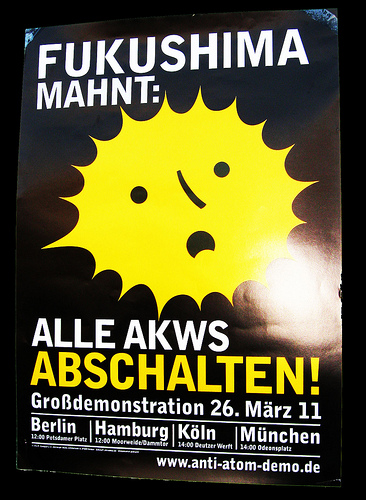I've always been interested in nuclear energy. I grew up on Long Island hearing stories about the infamous Shoreham plant. Shoreham was a GE Boiling Water Reactor (BWR) plant fully completed in 1984 but which never opened and was eventually decommissioned due to public backlash in the wake of the Three Mile Island scare in 1979 and Chernobyl accident in 1986. Most people I talked to had the Not in My Backyard (NIMBY) mentality as a creed with regard to nuclear energy. I had one uncle, though, who as a mechanical engineer had started his career in nuclear energy, and he'd tell me his side of the story.
From his insider perspective I came away with: "Nuclear energy is safe, reliable and more efficient than gas or coal. It just makes sense." The Shoreham story became for me the sad reminder of the progress that can be sacrificed when we let group-think and paranoia govern our decisions.
A personal commitment to public awareness
I decided then to make it a goal to promote education and awareness of nuclear energy to the public. In order to do that, I knew the first step would be to get myself an education on the matter.
Three months ago I started my new job as an engineer on the Emergent Response Team (ERT) at PSEG's Salem Generating Station in Southern New Jersey. Out of the first eight weeks there, six were spent in training. Safety training, orientation training (which covers the basic electrical, atomic, mechanical, civil, chemical principles governing a nuclear plant), and systems training--an in depth three-week course designed to teach you everything you need to know about nuclear systems, from reactor and core geometry to cooling water and the operation of emergency diesel generators.
Learning never stops here, especially when safety's involved. Every morning there's a safety message followed by an example of operational experience (OE) where we cover the lessons learned from an event at another nuclear plant.
Nuclear community's reaction to Fukushima
In the wake of the devastating events at the Fukushima Daiichi plant in Japan, it would have been easy for the nuclear industry in the US to point its finger and say "that won't happen here." They could have ignored it, but instead the industry took proactive measures to make sure nothing like that can happen here. NRC inspectors were shortly dispatched and are currently onsite at America's 104 nuclear reactors to assess safety and station response to accident scenarios modeling the one faced in Japan. The hope is that the more lessons we take away from this, the more prepared we'll be to prevent an event like this from occurring in the future.

The biggest obstacle, I feel, to the nuclear industry is public perception, most of which is fueled by fear and inaccurate information. The facts are out there they simply need to be presented to the public and the government officials in an intelligent way by people directly involved in the industry. After the recent earthquake and hurricane "shook" up the East Coast in August, I got several calls from relatives and friends asking how the station was holding up, that they had seen pictures of our generating station on the local news.
"Everything's fine. These sites aren't as fragile as the media makes them seem," I replied. When a station goes through licensing with the NRC, there is an extensive report that is filed called the Updated Final Safety Analysis Report or UFSAR. This report is constantly updated when any change is made that may affect the way a plant operates in the event of an emergency. The licensing basis also lays down margins that the plant must operate in to be found compliant with federal regulations. On top of that, each plant has its own more stringent safety margin that it operates in. For example, the NRC sets a maximum allowable yearly radiation dose of 5,000 miliRem for a worker at a nuclear plant, but the Administrative limit at Salem is 2,000 miliRem. So even though the law says you can safely receive 3,000 more miliRem, the organization makes sure you will not be anywhere close to that level.
In fact, the majority of nuclear workers at Salem are exposed to less than 50 miliRem per year. Compare that to the fact that a typical person will experience about 620 miliRem a year from natural and manmade sources including airplane trips, medical procedures, bananas, radon, and smoke detectors, and you can see how well protected our nuclear workers are.
A culture of safety
Safety is not just an industry motto, it really is a culture in nuclear. From designing plant structures to walking through the parking lot, attention to safety doesn't leave when you walk out the security door to go home for the day. You may get written up for not holding a handrail when going down stairs, for texting while walking through the parking lot. It's a principle. Everything is regulated, down to the chemical cleaners you can use in the bathroom, but it's for a reason, because we recognize that nuclear power is special and unique, and it's true, since few other industries could cause the devastation that nuclear energy can. Everyday we're reminded of our responsibility to the public and the environment to keep the plant running properly.
So the next time someone tells you nuclear energy is unsafe, just direct them to someone who works at a plant; they'll tell you if it wasn't safe we wouldn't work here, and we certainly wouldn't raise our families here.
Do you think most anti-nuclear protestors are well informed?
For more on this topic, check out these links:
Nuclear Commission Launches Review of U.S. Reactors After Japan Crisis
US NRC Fact Sheet on Biological Effects of Radiation
Introduction & History of the Shoreham Nuclear Power Plant



